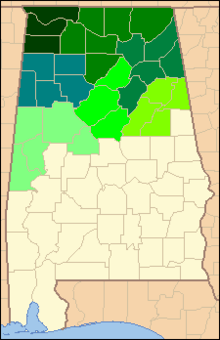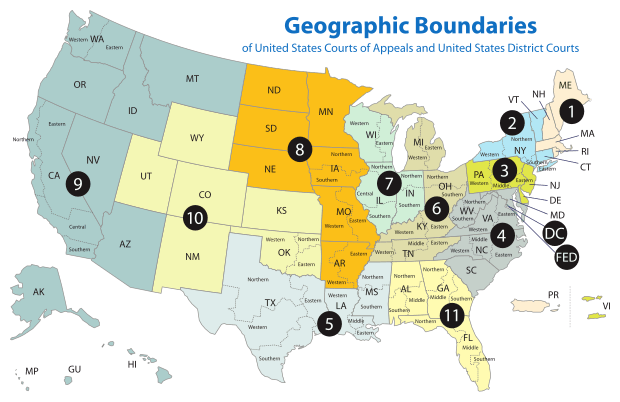United States District Court for the Northern District of Alabama
| United States District Court for the Northern District of Alabama | |
|---|---|
| (N.D. Ala.) | |
 | |
 | |
| Location | Birmingham |
| Appeals to | Eleventh Circuit |
| Established | March 10, 1824 |
| Judges | 8 |
| Chief Judge | Karon O. Bowdre |
| Officers of the court | |
| U.S. Attorney | Jay Town |
|
www | |
The United States District Court for the Northern District of Alabama (in case citations, N.D. Ala.) is a federal court in the Eleventh Circuit (except for patent claims and claims against the U.S. government under the Tucker Act, which are appealed to the Federal Circuit).
The District was established on March 10, 1824, with the division of the state into a Northern and Southern district. The circuit court itself was established on June 22, 1874.[1]
The United States Attorney's Office for the Northern District of Alabama represents the United States in civil and criminal litigation in the court. The current United States Attorney is Jay Town, who took office in August 2017.
Organization of the court
The United States District Court for the Northern District of Alabama is one of three federal judicial districts in Alabama.[2] Court for the District is held at Anniston, Birmingham, Decatur, Florence, Gadsden, Huntsville, and Tuscaloosa.
Eastern Division comprises the following counties: Calhoun, Clay, Cleburne, and Talladega.
Jasper Division comprises the following counties: Fayette, Lamar, Marion, Walker, and Winston.
Middle Division comprises the following counties: Cherokee, DeKalb, Etowah, Marshall, and St. Clair.
Northeastern Division comprises the following counties: Cullman, Jackson, Lawrence, Limestone, Madison, and Morgan.
Northwestern Division comprises the following counties: Colbert, Franklin, and Lauderdale.
Southern Division comprises the following counties: Blount, Jefferson, and Shelby.
Western Division comprises the following counties: Bibb, Greene, Pickens, Sumter, and Tuscaloosa.
Current judges
| # | Title | Judge | Duty station | Born | Term of service | Appointed by | ||
|---|---|---|---|---|---|---|---|---|
| Active | Chief | Senior | ||||||
| 32 | Chief Judge | Karon O. Bowdre | Birmingham | 1955 | 2001–present | 2013–present | — | G.W. Bush |
| 33 | District Judge | L. Scott Coogler | Tuscaloosa | 1959 | 2003–present | — | — | G.W. Bush |
| 34 | District Judge | R. David Proctor | Birmingham | 1960 | 2003–present | — | — | G.W. Bush |
| 36 | District Judge | Abdul Kallon | Birmingham | 1969 | 2010–present | — | — | Obama |
| 37 | District Judge | Madeline Hughes Haikala | Birmingham | 1964 | 2013–present | — | — | Obama |
| 38 | District Judge | Annemarie Carney Axon | Birmingham | 1973 | 2018–present | — | — | Trump |
| 39 | District Judge | Liles C. Burke | Huntsville | 1969 | beg. 2018 | — | — | Trump |
| 40 | District Judge | vacant | — | — | — | — | — | — |
| 21 | Senior Judge | James Hughes Hancock | inactive | 1931 | 1973–1996 | — | 1996–present | Nixon |
| 24 | Senior Judge | Robert Bruce Propst | inactive | 1931 | 1980–1996 | — | 1996–present | Carter |
| 28 | Senior Judge | Sharon Lovelace Blackburn | Birmingham | 1950 | 1991–2015 | 2006–2013 | 2015–present | G.H.W. Bush |
| 29 | Senior Judge | Charles Lynwood Smith Jr. | Huntsville | 1943 | 1995–2013 | — | 2013–present | Clinton |
| 31 | Senior Judge | Inge Prytz Johnson | inactive | 1945 | 1998–2012 | — | 2012–present | Clinton |
| 35 | Senior Judge | Virginia Emerson Hopkins | Birmingham | 1952 | 2004–2018 | — | 2018–present | G.W. Bush |
Vacancies and pending nominations
| # | Seat last held by | Vacancy reason | Date of vacancy | Nominee | Date of nomination |
|---|---|---|---|---|---|
| 5 | Virginia Emerson Hopkins | Senior Status | June 22, 2018 | Corey L. Maze | May 15, 2018 |
Former judges
| # | Judge | State | Born–died | Active service | Chief Judge | Senior status | Appointed by | Reason for termination |
|---|---|---|---|---|---|---|---|---|
| 1 | Charles Tait | AL | 1768–1835 | 1824[3]–1826 | — | — | Monroe | resignation |
| 2 | William Crawford | AL | 1784–1849 | 1826–1849 | — | — | J.Q. Adams | death |
| 3 | John Gayle | AL | 1792–1859 | 1849–1859 | — | — | Taylor | death |
| 4 | William Giles Jones | AL | 1808–1883 | 1859[4]–1861 | — | — | Buchanan | resignation |
| 5 | George Washington Lane | AL | 1806–1863 | 1861–1863 | — | — | Lincoln | death |
| 6 | Richard Busteed | AL | 1822–1898 | 1863[5]–1874 | — | — | Lincoln | resignation |
| 7 | John Bruce | AL | 1832–1901 | 1875–1901 | — | — | Grant | death |
| 8 | Thomas G. Jones | AL | 1844–1914 | 1901–1914 | — | — | T. Roosevelt | death |
| 9 | Oscar Richard Hundley | AL | 1855–1921 | 1907–1908 1908–1909 1909 |
— | — | T. Roosevelt T. Roosevelt Taft |
not confirmed[6] |
| 10 | William Irwin Grubb | AL | 1862–1935 | 1909–1935 | — | — | Taft | death |
| 11 | Henry De Lamar Clayton Jr. | AL | 1857–1929 | 1914–1929 | — | — | Wilson | death |
| 12 | Charles Brents Kennamer | AL | 1874–1955 | 1931–1936 | — | — | Hoover | reassignment to M.D. Ala. |
| 13 | David Jackson Davis | AL | 1878–1938 | 1935[7]–1938 | — | — | F. Roosevelt | death |
| 14 | Thomas Alexander Murphree | AL | 1883–1945 | 1938–1945 | — | — | F. Roosevelt | death |
| 15 | Clarence H. Mullins | AL | 1895–1957 | 1943–1953 | 1948–1953 | 1953–1957 | F. Roosevelt | death |
| 16 | Seybourn Harris Lynne | AL | 1907–2000 | 1946–1973 | 1953–1973 | 1973–2000 | Truman | death |
| 17 | Harlan Hobart Grooms | AL | 1900–1991 | 1953–1969 | — | 1969–1991 | Eisenhower | death |
| 18 | Clarence W. Allgood | AL | 1902–1991 | 1961[8]–1973 | — | 1973–1991 | Kennedy | death |
| 19 | Frank Hampton McFadden | AL | 1925–present | 1969–1982 | 1973–1982 | — | Nixon | resignation |
| 20 | Sam C. Pointer Jr. | AL | 1934–2008 | 1970–1999 | 1982–1999 | 1999–2000 | Nixon | retirement |
| 22 | Junius Foy Guin Jr. | AL | 1924–2016 | 1973–1989 | — | 1989–2016 | Nixon | death |
| 23 | Elbert Bertram Haltom Jr. | AL | 1922–2003 | 1980–1991 | — | 1991–2003 | Carter | death |
| 25 | U. W. Clemon | AL | 1943–present | 1980–2009 | 1999–2006 | — | Carter | retirement |
| 26 | William Marsh Acker Jr. | AL | 1927–2018 | 1982–1996 | — | 1996–2018 | Reagan | death |
| 27 | Edwin L. Nelson | AL | 1940–2003 | 1990–2003 | — | — | G.H.W. Bush | death |
| 30 | H. Dean Buttram Jr. | AL | 1950–present | 1998–2002 | — | — | Clinton | resignation |
Chief judges
Chief judges have administrative responsibilities with respect to their district court. Unlike the Supreme Court, where one justice is specifically nominated to be chief, the office of chief judge rotates among the district court judges. To be chief, a judge must have been in active service on the court for at least one year, be under the age of 65, and have not previously served as chief judge. A vacancy is filled by the judge highest in seniority among the group of qualified judges. The chief judge serves for a term of seven years or until age 70, whichever occurs first. The age restrictions are waived if no members of the court would otherwise be qualified for the position.
When the office was created in 1948, the chief judge was the longest-serving judge who had not elected to retire on what has since 1958 been known as senior status or declined to serve as chief judge. After August 6, 1959, judges could not become or remain chief after turning 70 years old. The current rules have been in operation since October 1, 1982.
Court Decisions
Lucy v. Adams (1955) – A court ruling which affirmed the right of all citizens to be accepted at the University of Alabama. The U.S. Supreme Court upheld the ruling.
Armstrong v. Birmingham Board of Education (1963) – The court dismissed the plaintiff's complaint. On appeal, the Fifth Circuit reversed and ordered the desegregation of Birmingham public schools.[9]
United States v. Wallace (1963) – The court exercised its ruling in Lucy v. Adams and ordered that colored students be permitted to enroll at the University of Alabama in Tuscaloosa. The court order led to the infamous Stand in the Schoolhouse Door incident with Governor George C. Wallace.[10]
Jackson v. Birmingham Board of Education (2002) – A reversal of the decision rendered by the district and Eleventh Circuit. The U.S. Supreme Court held that retaliation against a person on the basis of a sexual complaint is a form of sexual discrimination under Title IX.
Ledbetter v. Goodyear Tire & Rubber Co. (2003) – The U.S. Supreme Court reversed the decision of the district court, stating that employers cannot be sued under Title VII of the Civil Rights Act over race or gender discrimination if the claims are based on decisions over 180 days. The decision of the court led Congress to pass the Lilly Ledbetter Fair Pay Act in 2009.
United States v. Alabama (2011) – The court upheld most parts of Alabama HB 56, an anti-illegal immigration bill signed by Governor Robert J. Bentley. The Eleventh Circuit reversed, invalidating much of Alabama HB 56.[11]
Succession of seats
|
|
|
|
| ||||||||||||||||||||||||||||||||||||||||||||||||||||||||||||||||||||||||||||||||||
|
|
|
|
| ||||||||||||||||||||||||||||||||||||||||||||||||||||||||||
|
|
|
| ||||||||||||||||||||||||||||||||||||||
See also
Notes
- ↑ http://www.fjc.gov/history/home.nsf/page/courts_district_al.html U.S. District Courts of Alabama, Legislative history, Federal Judicial Center
- ↑ "28 U.S.C. § 81 - U.S. Code Title 28. Judiciary and Judicial Procedure § 81 - FindLaw". findlaw.com. Retrieved April 10, 2018.
- ↑ Initially appointed to the District of Alabama in 1820 by James Monroe; reassigned to both the Northern District of Alabama and the Southern District of Alabama in 1824.
- ↑ Recess appointment; formally nominated on January 23, 1860, confirmed by the United States Senate on January 30, 1860, and received commission on January 30, 1860.
- ↑ Recess appointment; formally nominated on January 5, 1864, confirmed by the United States Senate on January 20, 1864, and received commission on January 20, 1864.
- ↑ Recess appointment; the United States Senate later rejected the appointment; received a second recess appointment and was again rejected by the Senate; received a third recess appointment but resigned prior to consideration.
- ↑ Recess appointment; formally nominated on January 6, 1936, confirmed by the United States Senate on January 22, 1936, and received commission on January 28, 1936.
- ↑ Recess appointment; formally nominated on January 15, 1962, confirmed by the United States Senate on February 5, 1962, and received commission on February 9, 1962.
- ↑ http://www.leagle.com/decision/1963437220FSupp217_1398 Armstrong v. Birmingham Board of Education
- ↑ http://digital.archives.alabama.gov/cdm/ref/collection/voices/id/5665 United States v. Wallace
- ↑ http://www.ca11.uscourts.gov/opinions/ops/201114532.pdf United States v. Alabama
